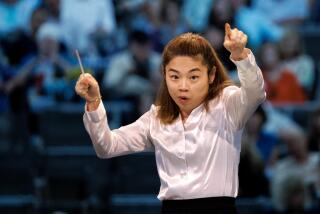DANCE REVIEWS : Despite Injury, Cal Ballet Show Goes On--but Not Very Well
SAN DIEGO — An eleventh-hour injury to guest artist Mark Lanham threw a monkey wrench in the California Ballet’s season opener at Sea World’s amphitheater Saturday night. But, in true show-business tradition, the show went on--with two undistinguished understudies substituting for the grounded star.
The loss of Lanham (who was slated to dance major roles in all three pieces) was unfortunate indeed, since the company’s complement of male dancers is particularly poor this year.
The program featured a splashy, Vegas-style laser show to set the sky ablaze for its grand finale. But the closest thing to on-stage pyrotechnics came from a pair of balletic masterworks--Act III of “Sleeping Beauty” and “Les Sylphides”--performed earlier in the evening.
Marius Petipa’s “Sleeping Beauty,” with its transcending Tchaikovsky score, is considered the definitive treatise on classical ballet technique. So it was disappointing that Stephen Hook, an erstwhile dancer with the company, had to be pressed into service to partner Karen Evans in the ballet’s grand pas de deux. Hook has neither the noble line nor the technical assurance required for the princely role, and he partnered Evans without displaying any emotional involvement in the action. As for his own solo variation, the less said the better.
Evans, on the other hand, was regal and radiant in her fairy tale finery, obviously relishing her role in this endearing classic.
William Starrett, another guest dancer with the company, delivered the strongest male dancing of the evening as the soaring Bluebird. Although the diminutive dancer could barely handle his Princess Florina (Sylvia Poolos) in the lifts, he was breezy and buoyant in his own variation, negotiating the jumps and rapid leg beats with aplomb.
The corps work in “Beauty” left much to be desired, but most of the solo spots were well-danced, particularly the pas de trois for Jewel Tweten, Debora Rumney and a very promising Jennifer Curry.
Michel Fokine’s “Les Sylphides” was the most successful piece on the program. California Ballet danced this pristine distillation of the Romantic ballet blanc in 1979 (coached by a student of Fokine’s). Inspired by the modern dances of iconoclast Isadora Duncan, and conceived less than 20 years after “Sleeping Beauty,” “Sylphides” is the seminal work of modern ballet--a great leap in style from Petipa’s brand of classicism--and it looked lovely in the alfresco setting, despite lapses in style among the ensemble.
The lead dancers (Poolos, Evans, and the company’s ever-appealing prima ballerina Denise Dabrowski) captured the essence of its style beautifully, executing its ethereal moves with fluid port de bras and appropriately elastic torsos.
David Crookes, an occasional soloist with the San Diego-based troupe, took a star turn in “Les Sylphides,” when Lanham was sidelined. He fared better than Hook in his crack at the limelight, but was too busy concentrating on the partnering demands to worry about subtleties of style.
A smoke-filled stage lit with contemporary laser beams signaled the return of “Opus 55”--introduced at last year’s Sea World show.
The balletic underpinnings of Charles Bennett’s laser ballet--form-fitting unitards and space-age lighting designs notwithstanding--were anything but revolutionary. They followed, for the most part, the changing aural ambiance of Sergei Rachmaninoff’s spellbinding “Variations on a Theme by Paganini,” without adding any magic of their own.
Although the laser beams were more cooperative at Saturday night’s opener than they were during last year’s premiere, the slim bands of green that spilled over the dancers as they spun their intricate patterns still looked more like gimmicky tag-alongs than integrated artistic elements. To exacerbate things, the belching smoke from frequent blasts by the fog machine had a mind of its own--eclipsing the dancers’ moves much of the time and contributing little to the overall effect.
There were a couple of standouts worth mentioning in “Opus 55”--Dabrowski and Patrick Nollet. Otherwise, the dancers seemed at a loss to keep up with its choreographic demands amid the onslaught of technology.
More to Read
The biggest entertainment stories
Get our big stories about Hollywood, film, television, music, arts, culture and more right in your inbox as soon as they publish.
You may occasionally receive promotional content from the Los Angeles Times.










